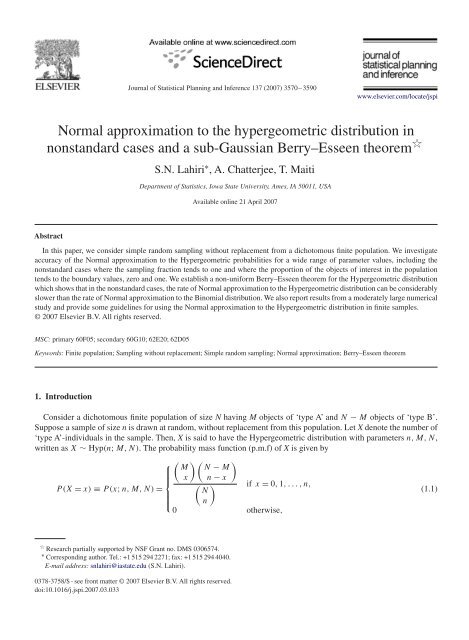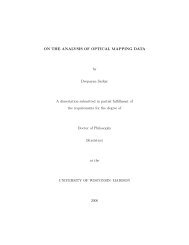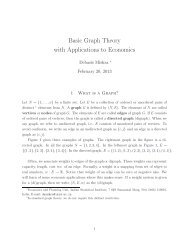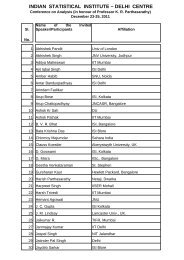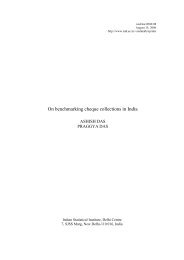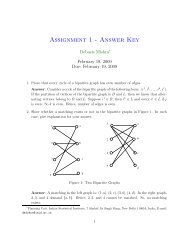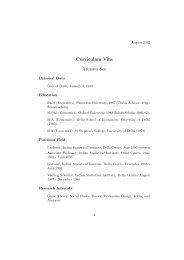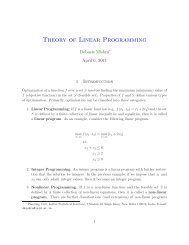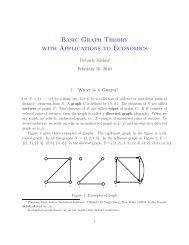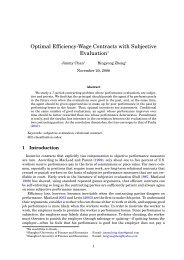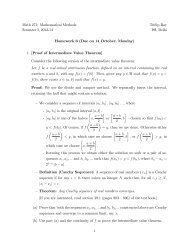Normal approximation to the hypergeometric distribution in ...
Normal approximation to the hypergeometric distribution in ...
Normal approximation to the hypergeometric distribution in ...
Create successful ePaper yourself
Turn your PDF publications into a flip-book with our unique Google optimized e-Paper software.
Journal of Statistical Plann<strong>in</strong>g and Inference 137 (2007) 3570 – 3590<br />
www.elsevier.com/locate/jspi<br />
<strong>Normal</strong> <strong>approximation</strong> <strong>to</strong> <strong>the</strong> <strong>hypergeometric</strong> <strong>distribution</strong> <strong>in</strong><br />
nonstandard cases and a sub-Gaussian Berry–Esseen <strong>the</strong>orem <br />
Abstract<br />
S.N. Lahiri ∗ , A. Chatterjee, T. Maiti<br />
Department of Statistics, Iowa State University, Ames, IA 50011, USA<br />
Available onl<strong>in</strong>e 21 April 2007<br />
In this paper, we consider simple random sampl<strong>in</strong>g without replacement from a dicho<strong>to</strong>mous f<strong>in</strong>ite population. We <strong>in</strong>vestigate<br />
accuracy of <strong>the</strong> <strong>Normal</strong> <strong>approximation</strong> <strong>to</strong> <strong>the</strong> Hypergeometric probabilities for a wide range of parameter values, <strong>in</strong>clud<strong>in</strong>g <strong>the</strong><br />
nonstandard cases where <strong>the</strong> sampl<strong>in</strong>g fraction tends <strong>to</strong> one and where <strong>the</strong> proportion of <strong>the</strong> objects of <strong>in</strong>terest <strong>in</strong> <strong>the</strong> population<br />
tends <strong>to</strong> <strong>the</strong> boundary values, zero and one. We establish a non-uniform Berry–Esseen <strong>the</strong>orem for <strong>the</strong> Hypergeometric <strong>distribution</strong><br />
which shows that <strong>in</strong> <strong>the</strong> nonstandard cases, <strong>the</strong> rate of <strong>Normal</strong> <strong>approximation</strong> <strong>to</strong> <strong>the</strong> Hypergeometric <strong>distribution</strong> can be considerably<br />
slower than <strong>the</strong> rate of <strong>Normal</strong> <strong>approximation</strong> <strong>to</strong> <strong>the</strong> B<strong>in</strong>omial <strong>distribution</strong>. We also report results from a moderately large numerical<br />
study and provide some guidel<strong>in</strong>es for us<strong>in</strong>g <strong>the</strong> <strong>Normal</strong> <strong>approximation</strong> <strong>to</strong> <strong>the</strong> Hypergeometric <strong>distribution</strong> <strong>in</strong> f<strong>in</strong>ite samples.<br />
© 2007 Elsevier B.V. All rights reserved.<br />
MSC: primary 60F05; secondary 60G10; 62E20; 62D05<br />
Keywords: F<strong>in</strong>ite population; Sampl<strong>in</strong>g without replacement; Simple random sampl<strong>in</strong>g; <strong>Normal</strong> <strong>approximation</strong>; Berry–Esseen <strong>the</strong>orem<br />
1. Introduction<br />
Consider a dicho<strong>to</strong>mous f<strong>in</strong>ite population of size N hav<strong>in</strong>g M objects of ‘type A’ and N − M objects of ‘type B’.<br />
Suppose a sample of size n is drawn at random, without replacement from this population. Let X denote <strong>the</strong> number of<br />
‘type A’-<strong>in</strong>dividuals <strong>in</strong> <strong>the</strong> sample. Then, X is said <strong>to</strong> have <strong>the</strong> Hypergeometric <strong>distribution</strong> with parameters n, M, N,<br />
written as X ∼ Hyp(n; M,N). The probability mass function (p.m.f) of X is given by<br />
⎧<br />
<br />
M N − M<br />
⎪⎨ x n − x<br />
if x = 0, 1,...,n,<br />
P(X= x) ≡ P(x; n, M, N) = N<br />
(1.1)<br />
⎪⎩ n<br />
0 o<strong>the</strong>rwise,<br />
Research partially supported by NSF Grant no. DMS 0306574.<br />
∗ Correspond<strong>in</strong>g author. Tel.: +1 515 294 2271; fax: +1 515 294 4040.<br />
E-mail address: snlahiri@iastate.edu (S.N. Lahiri).<br />
0378-3758/$ - see front matter © 2007 Elsevier B.V. All rights reserved.<br />
doi:10.1016/j.jspi.2007.03.033
Table 1<br />
Error of <strong>Normal</strong> <strong>approximation</strong><br />
S.N. Lahiri et al. / Journal of Statistical Plann<strong>in</strong>g and Inference 137 (2007) 3570 –3590 3571<br />
p f = 0.5 f = 0.6 f = 0.7 f = 0.8 f = 0.9<br />
0.5 0.0562 0.0574 0.0613 0.0701 0.0929<br />
0.6 0.0574 0.0593 0.0641 0.0743 0.0995<br />
0.7 0.0613 0.0641 0.0702 0.0822 0.1112<br />
0.8 0.0701 0.0743 0.0822 0.0972 0.1321<br />
0.9 0.0929 0.0995 0.1112 0.1321 0.1787<br />
Values of <strong>the</strong> absolute difference |P ((X−E(X))/Var(X)x)−(x)| at x=0 for different values of <strong>the</strong> parameters p and f, where X ∼ Hyp(n; M,N)<br />
and (·) is <strong>the</strong> cdf of <strong>the</strong> N(0, 1) <strong>distribution</strong>. Here, N = 200 and M = Np and n = Nf .<br />
where, for any two <strong>in</strong>tegers r 1 and s,<br />
⎧<br />
<br />
r ⎨ r!<br />
if 0s r,<br />
= s!(r − s)!<br />
s ⎩<br />
0 o<strong>the</strong>rwise,<br />
with 0! =1 and r! =1 · 2 ...r. Let f = n/N denote <strong>the</strong> sampl<strong>in</strong>g fraction and let p = M/N denote <strong>the</strong> proportion<br />
of <strong>the</strong> ‘type A’-objects <strong>in</strong> <strong>the</strong> population. The Hypergeometric <strong>distribution</strong> plays an important role <strong>in</strong> many areas of<br />
statistics, <strong>in</strong>clud<strong>in</strong>g sample surveys (Burste<strong>in</strong>, 1975; Wendell and Schmee, 1996), capture–recapture methods (Seber,<br />
1970; Wittes, 1972), analysis of cont<strong>in</strong>gency tables (Blyth and Staudte, 1997), statistical quality control (von Collani,<br />
1986; Patel and Samaranayake, 1991; Sohn, 1997), etc. <strong>Normal</strong> <strong>approximation</strong>s <strong>to</strong> <strong>the</strong> Hypergeometric probabilities<br />
P(.; n, M, N) of (1.1) are classical <strong>in</strong> <strong>the</strong> cases where <strong>the</strong> sampl<strong>in</strong>g fraction f and <strong>the</strong> proportion p are bounded away<br />
from 0 and 1; for example, see Feller (1971). The nonstandard cases correspond <strong>to</strong> <strong>the</strong> extremes where f or p take values<br />
near <strong>the</strong> boundary values 0 and 1. Although <strong>the</strong> nonstandard cases arise frequently <strong>in</strong> all <strong>the</strong>se areas of applications,<br />
<strong>the</strong> validity and accuracy of <strong>the</strong> normal <strong>approximation</strong> <strong>in</strong> such situations are not well studied. The quality of <strong>Normal</strong><br />
<strong>approximation</strong> deteriorates as <strong>the</strong> parameters f and p tend <strong>to</strong> <strong>the</strong>ir boundary values. For example, consider Table 1<br />
where <strong>the</strong> cumulative <strong>distribution</strong> function (cdf) of <strong>the</strong> centered and scaled version (X − E(X))/ √ Var(X) of X at zero<br />
is approximated by <strong>the</strong> <strong>Normal</strong> cdf at zero for different values of f and p.<br />
Table 1 gives <strong>the</strong> values of <strong>the</strong> absolute difference of <strong>the</strong> cdfs of (X − E(X))/ √ Var(X) and <strong>the</strong> standard <strong>Normal</strong><br />
<strong>distribution</strong> at x =0. The population size is fixed at N =200 while <strong>the</strong> proportion p of ‘type A’-objects and <strong>the</strong> sampl<strong>in</strong>g<br />
fraction f are varied over a range of 0.5–0.9 <strong>in</strong> <strong>in</strong>crements of 0.1 (<strong>the</strong> values of p and f between 0 and 0.5 are omitted<br />
due <strong>to</strong> <strong>the</strong> symmetry of <strong>the</strong> problem). In particular, for <strong>the</strong>se choices of N and f, <strong>the</strong> sample size n = Nf takes <strong>the</strong><br />
values 100, 120, 140, 160 and 180. Note that even for such moderately large sample sizes, <strong>the</strong> error of <strong>approximation</strong><br />
<strong>in</strong>creases steadily as p approaches <strong>the</strong> boundary value 1. Indeed, for p = 0.9 and f = 0.9, <strong>the</strong> error of <strong>approximation</strong><br />
is as high as 0.179 at <strong>the</strong> orig<strong>in</strong> <strong>in</strong> <strong>the</strong> f<strong>in</strong>ite population sampl<strong>in</strong>g framework, which is significantly higher than 0.036,<br />
<strong>the</strong> error of <strong>Normal</strong> <strong>approximation</strong> <strong>to</strong> <strong>the</strong> B<strong>in</strong>omial cdf with parameters n = 180 and p = 0.9. This shows that <strong>the</strong><br />
commonly known <strong>approximation</strong> results for <strong>the</strong> ‘with replacement sampl<strong>in</strong>g’ (or sampl<strong>in</strong>g from an <strong>in</strong>f<strong>in</strong>ite population)<br />
case do not give a representative picture <strong>in</strong> <strong>the</strong> f<strong>in</strong>ite population sett<strong>in</strong>g when <strong>the</strong> parameters p and f are close <strong>to</strong> <strong>the</strong>ir<br />
boundary values. For a better understand<strong>in</strong>g, one needs <strong>to</strong> be able <strong>to</strong> quantify <strong>the</strong> accuracy of <strong>Normal</strong> <strong>approximation</strong><br />
as a function of N, p and f <strong>in</strong> <strong>the</strong> f<strong>in</strong>ite population sett<strong>in</strong>g.<br />
In this paper, we derive a non-uniform Berry–Esseen <strong>the</strong>orem on <strong>Normal</strong> <strong>approximation</strong> <strong>to</strong> <strong>the</strong> Hypergeometric<br />
<strong>distribution</strong> for a wide range of values of p and f, allow<strong>in</strong>g <strong>the</strong>se parameters go <strong>to</strong> <strong>the</strong> extreme po<strong>in</strong>ts 0, 1. The nonuniform<br />
bound <strong>in</strong> <strong>the</strong> Berry–Esseen <strong>the</strong>orem shows that <strong>the</strong> difference of <strong>the</strong> cdfs of (X − E(X))/ √ Var(X) and of a<br />
standard <strong>Normal</strong> variate at a po<strong>in</strong>t x is bounded above by<br />
g(x)[Nf (1 − f)p(1 − p)] −1/2 , (1.3)<br />
where <strong>the</strong> function g(x) = g(x; p, f ) is bounded and decays at an exponential (sub-Gaussian) rate as a function of x.<br />
As a corollary, we also derive an exponential (sub-Gaussian) probability <strong>in</strong>equality for <strong>the</strong> tails of X, which may be<br />
of <strong>in</strong>dependent <strong>in</strong>terest. Both <strong>the</strong> sub-Gaussian Berry–Esseen <strong>the</strong>orem and <strong>the</strong> exponential <strong>in</strong>equality seem <strong>to</strong> be new<br />
even <strong>in</strong> <strong>the</strong> standard case.<br />
(1.2)
3572 S.N. Lahiri et al. / Journal of Statistical Plann<strong>in</strong>g and Inference 137 (2007) 3570 – 3590<br />
Note that <strong>the</strong> Hypergeometric variable X can be expressed as <strong>the</strong> sum of a collection of n dependent Bernoulli<br />
random variables and (1.3) yields <strong>the</strong> uniform bound O([Np(1 − p)f (1 − f)] −1/2 ) on <strong>the</strong> error of <strong>Normal</strong> <strong>approximation</strong><br />
<strong>to</strong> <strong>the</strong> <strong>distribution</strong> of X. This rate is equivalent <strong>to</strong> <strong>the</strong> standard Berry–Esseen rate O(n −1/2 ) for <strong>the</strong><br />
B<strong>in</strong>omial <strong>distribution</strong> only when p is bounded away from 0 and 1 and f bounded away from 1. However, for p<br />
and f close <strong>to</strong> <strong>the</strong>se boundary po<strong>in</strong>ts, <strong>the</strong> rate of <strong>approximation</strong> can be substantially slower. In such situations,<br />
<strong>the</strong> dependence of <strong>the</strong> Bernoulli random variables associated with X has a nontrivial effect on <strong>the</strong> accuracy of <strong>the</strong><br />
<strong>Normal</strong> <strong>approximation</strong>. This provides <strong>the</strong> <strong>the</strong>oretical justification for <strong>the</strong> observed difference <strong>in</strong> <strong>the</strong> accuracy of<br />
<strong>Normal</strong> <strong>approximation</strong>s <strong>to</strong> <strong>the</strong> B<strong>in</strong>omial probabilities and <strong>to</strong> <strong>the</strong> Hypergeometric probabilities <strong>in</strong> <strong>the</strong> nonstandard<br />
cases.<br />
The <strong>the</strong>oretical f<strong>in</strong>d<strong>in</strong>gs of <strong>the</strong> paper and <strong>the</strong> numerical example <strong>in</strong> Table 1 also show that <strong>the</strong> exist<strong>in</strong>g guidel<strong>in</strong>es for<br />
apply<strong>in</strong>g <strong>the</strong> <strong>Normal</strong> <strong>approximation</strong> <strong>to</strong> <strong>the</strong> B<strong>in</strong>omial <strong>distribution</strong> (based on <strong>in</strong>dependent Bernoulli random variables)<br />
are not appropriate for <strong>the</strong> Hypergeometric <strong>distribution</strong> <strong>in</strong> <strong>the</strong> nonstandard cases. To formulate a work<strong>in</strong>g guidel<strong>in</strong>e <strong>in</strong><br />
such situations, we conduct a moderately large numerical study and <strong>in</strong>vestigate <strong>the</strong> effect of <strong>the</strong> dependence <strong>in</strong> f<strong>in</strong>ite<br />
samples. On <strong>the</strong> basis of <strong>the</strong> numerical study, <strong>in</strong> Section 3, we provide some ‘quick and easy’ guidel<strong>in</strong>es for assess<strong>in</strong>g<br />
<strong>the</strong> error of <strong>Normal</strong> <strong>approximation</strong> <strong>to</strong> <strong>the</strong> Hypergeometric <strong>distribution</strong> <strong>in</strong> practice.<br />
The rest of <strong>the</strong> paper is organized as follows. We conclude Section 1 with a brief literature review. Section 2<br />
<strong>in</strong>troduces <strong>the</strong> asymp<strong>to</strong>tic framework and states <strong>the</strong> Berry–Esseen <strong>the</strong>orem and <strong>the</strong> exponential <strong>in</strong>equality. Results<br />
from <strong>the</strong> numerical study are reported <strong>in</strong> Section 3. Proofs of all <strong>the</strong> results are given <strong>in</strong> Section 4.<br />
For results on <strong>Normal</strong> <strong>approximation</strong>s <strong>to</strong> Hypergeometric probabilities <strong>in</strong> <strong>the</strong> standard case where <strong>the</strong> sampl<strong>in</strong>g<br />
fraction f and <strong>the</strong> proportion p are bounded away from 0 and 1, see Feller (1971). For general p and f, Nicholson (1956)<br />
derived some very precise bounds for <strong>the</strong> po<strong>in</strong>t probabilities P(.; n, M, N) (cf. (1.1)) us<strong>in</strong>g some special normalizations<br />
of <strong>the</strong> Hypergeometric random variable X. General methods for prov<strong>in</strong>g <strong>the</strong> central limit <strong>the</strong>orem (CLT) for sample<br />
means under sampl<strong>in</strong>g without replacement from f<strong>in</strong>ite populations are given by Madow (1948), Erdos and Renyi<br />
(1959), and Hajek (1960). In relation <strong>to</strong> <strong>the</strong> earlier work, <strong>the</strong> ma<strong>in</strong> contribution of our paper is <strong>to</strong> establish a nonuniform<br />
Berry–Esseen <strong>the</strong>orem for <strong>the</strong> Hypergeometric <strong>distribution</strong> for a wide range of parameter values, <strong>in</strong>clud<strong>in</strong>g<br />
<strong>the</strong> nonstandard case, and <strong>to</strong> provide some practical guidel<strong>in</strong>es for us<strong>in</strong>g <strong>the</strong> <strong>Normal</strong> <strong>approximation</strong> <strong>in</strong> f<strong>in</strong>ite sample<br />
applications.<br />
2. Ma<strong>in</strong> results<br />
Let r be a positive <strong>in</strong>teger valued variable and for each r ∈ N (where N ={1, 2,...}), let Xr be a random variable<br />
hav<strong>in</strong>g <strong>the</strong> Hypergeometric <strong>distribution</strong> of (1.1) with parameters (nr,Mr,Nr), where nr,Mr,Nr ∈ N. Thus we consider<br />
a sequence of dicho<strong>to</strong>mous f<strong>in</strong>ite populations <strong>in</strong>dexed by r, with <strong>the</strong> population of objects of type A and <strong>the</strong> sampl<strong>in</strong>g<br />
fraction, respectively, given by<br />
Let<br />
pr = Mr<br />
Nr<br />
and fr = nr<br />
Nr<br />
for all r ∈ N. (2.1)<br />
2 r ≡ Nrprqrfr(1 − fr), (2.2)<br />
where qr = 1 − pr. Also, let (·) and (·), respectively, denote <strong>the</strong> density and <strong>the</strong> <strong>distribution</strong> function of a standard<br />
<strong>Normal</strong> random variable, i.e., (x) = (1/ √ 2) exp(−x2 /2), x ∈ R and (x) = x<br />
−∞ (t) dt, x ∈ R. Let I(·) denote<br />
<strong>the</strong> <strong>in</strong>dica<strong>to</strong>r function. For x,y ∈ R, write x ∧ y = m<strong>in</strong>{x,y}. Def<strong>in</strong>e<br />
r = 1<br />
10 (max(a1r, 2)) −1 , r1, (2.3)<br />
where a1r = ( ¯<br />
fr + 4)/4(1 − ¯<br />
fr) and where ¯<br />
fr = m<strong>in</strong>{fr, 1 − fr}. Then, we have <strong>the</strong> follow<strong>in</strong>g result.<br />
Theorem 1. Suppose that Xr ∼ Hyp(nr,Mr,Nr), r ∈ N. Assume that r is such that:<br />
rr > 1. (2.4)
S.N. Lahiri et al. / Journal of Statistical Plann<strong>in</strong>g and Inference 137 (2007) 3570 –3590 3573<br />
Then <strong>the</strong>re exists universal constants C1,C2 ∈ (0, ∞) (not depend<strong>in</strong>g on r, nr,Mr and Nr) such that:<br />
<br />
<br />
<br />
P <br />
Xr − nrpr<br />
C1<br />
x − (x) <br />
1 +|x|<br />
r<br />
<br />
r<br />
2<br />
r(x) exp(−C2x 2 2 r (x)) (2.5)<br />
for all x ∈ R, where r(x) = qrI(x0) + prI(x0).<br />
Theorem 1 is a non-uniform Berry–Esseen <strong>the</strong>orem for <strong>the</strong> Hypergeometric <strong>distribution</strong>. It shows that <strong>the</strong> error of<br />
<strong>Normal</strong> <strong>approximation</strong> <strong>to</strong> <strong>the</strong> Hypergeometric <strong>distribution</strong> dies at a sub-Gaussian rate <strong>in</strong> <strong>the</strong> tails. The only condition<br />
needed for <strong>the</strong> validity of this bound is (2.4). It is easy <strong>to</strong> check that<br />
<br />
r ∈ 1<br />
25 , 1<br />
20<br />
(2.6)<br />
for all r satisfy<strong>in</strong>g (2.4). Hence, <strong>the</strong> bound <strong>in</strong> (2.5) is available for all r such that r 25.<br />
As po<strong>in</strong>ted out <strong>in</strong> Section 1, when both <strong>the</strong> sequences {pr} {r 1} and {fr} {r 1} are bounded away from 0 and 1, <strong>the</strong><br />
rate of <strong>approximation</strong> <strong>in</strong> Theorem 1 matches <strong>the</strong> standard rate O(n −1/2<br />
r ) of <strong>Normal</strong> <strong>approximation</strong> for <strong>the</strong> sum of nr<br />
iid random variables with a f<strong>in</strong>ite third moment. Although <strong>the</strong> Hypergeometric random variable Xr can be written as<br />
a sum of nr dependent Bernoulli (pr) variables, <strong>the</strong> lack of <strong>in</strong>dependence of <strong>the</strong> summands does not affect <strong>the</strong> rate of<br />
<strong>Normal</strong> <strong>approximation</strong> as long as <strong>the</strong> sequence {pr} r 1 is bounded away from 0 and 1 and {fr} r 1 is bounded away<br />
from 1. On <strong>the</strong> o<strong>the</strong>r hand, if ei<strong>the</strong>r of <strong>the</strong> sequences {pr} {r 1} and {fr} {r 1} converge <strong>to</strong> one of <strong>the</strong> extreme values 0<br />
and 1, <strong>the</strong>n<br />
r = o(n 1/2<br />
r ) as r →∞<br />
and <strong>the</strong> rate of <strong>Normal</strong> <strong>approximation</strong> <strong>to</strong> <strong>the</strong> Hypergeometric <strong>distribution</strong> is <strong>in</strong>deed worse than <strong>the</strong> standard rate O(n −1/2<br />
r )<br />
<strong>in</strong> such nonstandard cases.<br />
An immediate consequence of Theorem 1 is <strong>the</strong> follow<strong>in</strong>g exponential (sub-Gaussian) probability bound on <strong>the</strong> tails<br />
of Xr.<br />
Theorem 2. Suppose that Xr ∼ Hyp(nr,Mr,Nr), r ∈ N. Then, <strong>the</strong>re exist universal constants C3,C4 ∈ (0, ∞) (not<br />
depend<strong>in</strong>g on r, nr,Mr,Nr) such that for all r satisfy<strong>in</strong>g (2.4),<br />
<br />
Xr − nrpr <br />
P<br />
<br />
x<br />
<br />
C3<br />
<br />
(pr ∧ qr) 3 exp(−C4x 2 [pr ∧ qr] 2 ) for all x>0.<br />
r<br />
3. Numerical results<br />
To ga<strong>in</strong> some <strong>in</strong>sight <strong>in</strong><strong>to</strong> <strong>the</strong> quality of <strong>Normal</strong> <strong>approximation</strong> <strong>to</strong> <strong>the</strong> Hypergeometric <strong>distribution</strong> <strong>in</strong> f<strong>in</strong>ite samples<br />
and <strong>to</strong> compare it with <strong>the</strong> accuracy <strong>in</strong> <strong>the</strong> case of <strong>the</strong> B<strong>in</strong>omial <strong>distribution</strong>, first we consider some jo<strong>in</strong>t plots of <strong>the</strong><br />
cdfs of normalized Hypergeometric and B<strong>in</strong>omial random variables aga<strong>in</strong>st <strong>the</strong> standard <strong>Normal</strong> cdf. Figs. 1–5 show<br />
<strong>the</strong>se plots for different values of <strong>the</strong> parameters n and p for N = 60, 200.<br />
From <strong>the</strong> figures, it follows that <strong>the</strong> quality of <strong>Normal</strong> <strong>approximation</strong> <strong>to</strong> <strong>the</strong> Hypergeometric <strong>distribution</strong> is comparable<br />
<strong>to</strong> that for <strong>the</strong> B<strong>in</strong>omial <strong>distribution</strong> for values of f and p close <strong>to</strong> 0.5, but <strong>the</strong>re is a stark loss of accuracy for high values<br />
of f and p.<br />
Next, <strong>to</strong> get a quantitative picture of <strong>the</strong> error of <strong>Normal</strong> <strong>approximation</strong>, we conducted a moderately large numerical<br />
study with different values of <strong>the</strong> population size N and with different values of <strong>the</strong> parameters p and f. The population<br />
sizes considered were N = 60, 200, 500, 2000. For a given value of N, <strong>the</strong> set of values of p and f considered was<br />
{0.5, 0.6, 0.7, 0.8, 0.9}. We considered <strong>the</strong> Kolmogorov distance, i.e., <strong>the</strong> maximal distance between <strong>the</strong> cdfs of <strong>the</strong><br />
normalized Hypergeometric variable and a standard <strong>Normal</strong> variable as a measure of accuracy. More specifically, <strong>the</strong><br />
measure of accuracy for <strong>the</strong> Hypergeometric case is def<strong>in</strong>ed as<br />
<br />
<br />
(N,p,f)= <br />
P <br />
X − np<br />
<br />
x<br />
<br />
<br />
− (x) <br />
, (3.1)<br />
where X ∼ Hyp(n, M, N), f = n/N, p = M/N, 2 = Nf (1 − f)p(1 − p) and (·) denotes <strong>the</strong> cdf of <strong>the</strong> N(0,1)<br />
<strong>distribution</strong>.
3574 S.N. Lahiri et al. / Journal of Statistical Plann<strong>in</strong>g and Inference 137 (2007) 3570 – 3590<br />
y (CDF)<br />
1.0<br />
0.8<br />
0.6<br />
0.4<br />
0.2<br />
0.0<br />
Hypergeometric<br />
B<strong>in</strong>omial<br />
<strong>Normal</strong><br />
-5 0<br />
x (Standardised)<br />
Fig. 1. A plot of <strong>the</strong> cdfs of normalized Hypergeometric and B<strong>in</strong>omial random variables aga<strong>in</strong>st <strong>the</strong> standard <strong>Normal</strong> cdf for <strong>the</strong> parameter values<br />
N = 60, p = 0.5 and f = 0.5.<br />
y (CDF)<br />
1.0<br />
0.8<br />
0.6<br />
0.4<br />
0.2<br />
0.0<br />
Hypergeometric<br />
B<strong>in</strong>omial<br />
<strong>Normal</strong><br />
-15 -10 -5 0 5 10 15<br />
x (Standardised)<br />
Fig. 2. A plot of <strong>the</strong> cdfs of normalized Hypergeometric and B<strong>in</strong>omial random variables aga<strong>in</strong>st <strong>the</strong> standard <strong>Normal</strong> cdf for <strong>the</strong> parameter values<br />
N = 200, p = 0.5 and f = 0.5.<br />
Tables 2–5 give <strong>the</strong> values of (N,p,f)for different comb<strong>in</strong>ations of <strong>the</strong> parameter values as <strong>in</strong>dicated above. For<br />
comparison, we also <strong>in</strong>cluded <strong>the</strong> values of <strong>the</strong> maximal distance of <strong>the</strong> cdfs of normalized B<strong>in</strong>omial (n, p) and N(0,1)<br />
random variables.<br />
From Tables 2–5, it follows that <strong>the</strong> accuracy of <strong>the</strong> <strong>Normal</strong> <strong>approximation</strong> <strong>to</strong> <strong>the</strong> Hypergeometric <strong>distribution</strong><br />
deteriorates as p or f tend <strong>to</strong> <strong>the</strong> boundary value 1. Unlike <strong>the</strong> case of <strong>Normal</strong> <strong>approximation</strong> <strong>to</strong> <strong>the</strong> B<strong>in</strong>omial <strong>distribution</strong>,<br />
<strong>the</strong> values of <strong>the</strong> sample size n and p alone are not a good <strong>in</strong>dica<strong>to</strong>r of <strong>the</strong> level of accuracy atta<strong>in</strong>able <strong>in</strong> this case.<br />
For example, for an iid sample of size n = 54 with p = 0.8, one may expect a reasonable accuracy of <strong>the</strong> <strong>Normal</strong><br />
5
y (CDF)<br />
S.N. Lahiri et al. / Journal of Statistical Plann<strong>in</strong>g and Inference 137 (2007) 3570 –3590 3575<br />
1.0<br />
0.8<br />
0.6<br />
0.4<br />
0.2<br />
0.0<br />
Hypergeometric<br />
B<strong>in</strong>omial<br />
<strong>Normal</strong><br />
-20 -15 -10 -5 0<br />
x (Standardised)<br />
Fig. 3. A plot of <strong>the</strong> cdfs of normalized Hypergeometric and B<strong>in</strong>omial random variables aga<strong>in</strong>st <strong>the</strong> standard <strong>Normal</strong> cdf for <strong>the</strong> parameter values<br />
N = 60, p = 0.9 and f = 0.7.<br />
y (CDF)<br />
1.0<br />
0.8<br />
0.6<br />
0.4<br />
0.2<br />
0.0<br />
Hypergeometric<br />
B<strong>in</strong>omial<br />
<strong>Normal</strong><br />
-20 -15 -10 -5 0<br />
x (Standardised)<br />
Fig. 4. A plot of <strong>the</strong> cdfs of normalized Hypergeometric and B<strong>in</strong>omial random variables aga<strong>in</strong>st <strong>the</strong> standard <strong>Normal</strong> cdf for <strong>the</strong> parameter values<br />
N = 60, p = 0.9 and f = 0.8.<br />
<strong>approximation</strong>; <strong>the</strong> maximal error of <strong>approximation</strong> <strong>to</strong> <strong>the</strong> B<strong>in</strong>omial (54, 0.8) <strong>distribution</strong> is 0.0803. However, with<br />
N = 60, n = 54 and p = 0.9, <strong>the</strong> maximal error of <strong>Normal</strong> <strong>approximation</strong> <strong>to</strong> <strong>the</strong> Hypergeometric <strong>distribution</strong> is as high<br />
as 0.4633, mak<strong>in</strong>g <strong>the</strong> <strong>approximation</strong> practically useless. With about a 9-fold <strong>in</strong>crease <strong>in</strong> <strong>the</strong> sample size, at n = 450,<br />
<strong>the</strong> accuracy of <strong>the</strong> <strong>approximation</strong> <strong>in</strong> <strong>the</strong> Hypergeometric case only improves <strong>to</strong> 0.1683 for <strong>the</strong> same values of f and p.<br />
The correspond<strong>in</strong>g maximal error for <strong>the</strong> <strong>Normal</strong> <strong>approximation</strong> <strong>to</strong> <strong>the</strong> B<strong>in</strong>omial <strong>distribution</strong> with parameters n = 450<br />
and p = 0.8 is only 0.0282. Thus, <strong>the</strong> loss <strong>in</strong> accuracy <strong>in</strong> this case is an as<strong>to</strong>und<strong>in</strong>g 600% compared <strong>to</strong> <strong>the</strong> B<strong>in</strong>omial<br />
5
3576 S.N. Lahiri et al. / Journal of Statistical Plann<strong>in</strong>g and Inference 137 (2007) 3570 – 3590<br />
y (CDF)<br />
1.0<br />
0.8<br />
0.6<br />
0.4<br />
0.2<br />
0.0<br />
Hypergeometric<br />
B<strong>in</strong>omial<br />
<strong>Normal</strong><br />
-20 -15 -10 -5 0<br />
x (Standardised)<br />
Fig. 5. A plot of <strong>the</strong> cdfs of normalized Hypergeometric and B<strong>in</strong>omial random variables aga<strong>in</strong>st <strong>the</strong> standard <strong>Normal</strong> cdf for <strong>the</strong> parameter values<br />
N = 60, p = 0.9 and f = 0.9.<br />
Table 2<br />
Values of <strong>the</strong> maximal error of <strong>Normal</strong> <strong>approximation</strong> <strong>to</strong> Hypergeometric <strong>distribution</strong> (viz., (N,p,f)of (3.1)) at N = 60 and <strong>the</strong> correspond<strong>in</strong>g<br />
values of <strong>the</strong> maximal error for <strong>the</strong> B<strong>in</strong>omial (n, p) <strong>distribution</strong> where n = Nf and p, f ∈{0.5, 0.6, 0.7, 0.8, 0.9}<br />
Hypergeometric B<strong>in</strong>omial<br />
n = 30 36 42 48 54 n = 30 36 42 48 54<br />
p = 0.5 0.1017 0.1038 0.1106 0.1260 0.1646 0.0722 0.0660 0.0612 0.0573 0.0540<br />
p = 0.6 0.1038 0.1066 0.1171 0.1284 0.1817 0.0785 0.0722 0.0661 0.0626 0.0588<br />
p = 0.7 0.1106 0.1171 0.1283 0.1476 0.1844 0.0888 0.0808 0.0757 0.0711 0.0670<br />
p = 0.8 0.2268 0.2528 0.2896 0.3480 0.4633 0.1070 0.0992 0.0922 0.0859 0.0803<br />
p = 0.9 0.3128 0.3550 0.4046 0.4633 0.7169 0.1474 0.1391 0.1289 0.1184 0.1145<br />
Table 3<br />
Values of <strong>the</strong> maximal error of <strong>Normal</strong> <strong>approximation</strong> <strong>to</strong> Hypergeometric <strong>distribution</strong> (viz., (N,p,f)of (3.1)) at N = 200 and <strong>the</strong> correspond<strong>in</strong>g<br />
values of <strong>the</strong> maximal error for <strong>the</strong> B<strong>in</strong>omial (n, p) <strong>distribution</strong> where n = Nf and p, f ∈{0.5, 0.6, 0.7, 0.8, 0.9}<br />
Hypergeometric B<strong>in</strong>omial<br />
n = 100 120 140 160 180 n = 100 120 140 160 180<br />
p = 0.5 0.0562 0.0574 0.0613 0.0701 0.0929 0.0398 0.0363 0.0337 0.0315 0.0297<br />
p = 0.6 0.0574 0.0593 0.0641 0.0743 0.0995 0.0433 0.0395 0.0366 0.0343 0.0323<br />
p = 0.7 0.0613 0.0641 0.0702 0.0822 0.1112 0.0491 0.0449 0.0416 0.0389 0.0367<br />
p = 0.8 0.1261 0.1373 0.1559 0.1887 0.2634 0.0595 0.0543 0.0503 0.0471 0.0444<br />
p = 0.9 0.1764 0.1922 0.2181 0.2634 0.3652 0.0832 0.0761 0.0705 0.0661 0.0623<br />
case. Indeed, similar high levels of loss <strong>in</strong> accuracy occur for values of f and p near 1 even when <strong>the</strong> population size N<br />
is <strong>in</strong>creased <strong>to</strong> 2000 and beyond. As a consequence, <strong>the</strong> commonly used guidel<strong>in</strong>es for <strong>the</strong> accuracy <strong>in</strong> <strong>the</strong> B<strong>in</strong>omial<br />
case can be mislead<strong>in</strong>g for assess<strong>in</strong>g accuracy of <strong>the</strong> <strong>Normal</strong> <strong>approximation</strong> <strong>to</strong> <strong>the</strong> Hypergeometric <strong>distribution</strong> <strong>in</strong> <strong>the</strong><br />
extreme cases.<br />
5
S.N. Lahiri et al. / Journal of Statistical Plann<strong>in</strong>g and Inference 137 (2007) 3570 –3590 3577<br />
Table 4<br />
Values of <strong>the</strong> maximal error of <strong>Normal</strong> <strong>approximation</strong> <strong>to</strong> Hypergeometric <strong>distribution</strong> (viz., (N,p,f)of (3.1)) at N = 500 and <strong>the</strong> correspond<strong>in</strong>g<br />
values of <strong>the</strong> maximal error for <strong>the</strong> B<strong>in</strong>omial (n, p) <strong>distribution</strong> where n = Nf and p, f ∈{0.5, 0.6, 0.7, 0.8, 0.9}<br />
Hypergeometric B<strong>in</strong>omial<br />
n = 250 300 350 400 450 n = 250 300 350 400 450<br />
p = 0.5 0.0356 0.0364 0.0389 0.0445 0.0592 0.0252 0.0230 0.0213 0.0199 0.0188<br />
p = 0.6 0.0364 0.0376 0.0407 0.0472 0.0635 0.0274 0.0250 0.0232 0.0217 0.0205<br />
p = 0.7 0.0389 0.0407 0.0446 0.0523 0.0712 0.0311 0.0284 0.0263 0.0246 0.0232<br />
p = 0.8 0.0801 0.0872 0.0990 0.1200 0.1683 0.0378 0.0345 0.0319 0.0299 0.0282<br />
p = 0.9 0.1124 0.1224 0.1390 0.1683 0.2355 0.0530 0.0484 0.0449 0.0420 0.0396<br />
Table 5<br />
Values of <strong>the</strong> maximal error of <strong>Normal</strong> <strong>approximation</strong> <strong>to</strong> Hypergeometric <strong>distribution</strong> (viz., (N,p,f)of (3.1)) at N = 2000 and <strong>the</strong> correspond<strong>in</strong>g<br />
values of <strong>the</strong> maximal error for <strong>the</strong> B<strong>in</strong>omial (n, p) <strong>distribution</strong> where n = Nf and p, f ∈{0.5, 0.6, 0.7, 0.8, 0.9}<br />
Hypergeometric B<strong>in</strong>omial<br />
n = 1000 1200 1400 1600 1800 n = 1000 1200 1400 1600 1800<br />
p = 0.5 0.0178 0.0182 0.0195 0.0223 0.0297 0.0126 0.0115 0.0107 0.0010 0.0094<br />
p = 0.6 0.0182 0.0188 0.0204 0.0237 0.0319 0.0137 0.0125 0.0116 0.0109 0.0102<br />
p = 0.7 0.0195 0.0204 0.0224 0.0263 0.0358 0.0156 0.0142 0.0132 0.0123 0.0116<br />
p = 0.8 0.0401 0.0437 0.0496 0.0602 0.0846 0.0189 0.0173 0.0160 0.0150 0.0141<br />
p = 0.9 0.0564 0.0614 0.0698 0.0846 0.1189 0.0266 0.0243 0.0225 0.0210 0.0198<br />
From Tables 2–5, it also follows that for a given value of N, if <strong>the</strong> parameter p is held fixed at a given level, <strong>the</strong><br />
maximal error of <strong>approximation</strong> <strong>to</strong> <strong>the</strong> Hypergeometric <strong>distribution</strong> <strong>in</strong>creases mono<strong>to</strong>nically as <strong>the</strong> value of f (i.e.,<br />
n) <strong>in</strong>creases, and vice versa. However, <strong>the</strong> sample size n and <strong>the</strong> value of p alone do not give a true <strong>in</strong>dication of<br />
<strong>the</strong> accuracy of <strong>the</strong> <strong>Normal</strong> <strong>approximation</strong> <strong>to</strong> <strong>the</strong> Hypergeometric <strong>distribution</strong>. To get a better estimate of <strong>the</strong> level of<br />
accuracy, one must consider <strong>the</strong> comb<strong>in</strong>ed effect of all three parameters N, f and p. Theorem 1 implies that <strong>the</strong> comb<strong>in</strong>ed<br />
effect of all three parameters on <strong>the</strong> maximal error of <strong>approximation</strong> can be expressed <strong>in</strong> terms of 1/(N,p,f), where<br />
[(N,p,f)] 2 = Nfp(1 − p)(1 − f). To that effect, we def<strong>in</strong>e <strong>the</strong> co-efficient c(N, p, f ) ∈ (0, ∞) by <strong>the</strong> relation<br />
Thus,<br />
c(N, p, f ) = (N,p,f)(N,p,f). (3.2)<br />
(N,p,f)≡ c(N, p, f )[(N,p,f)] −1 .<br />
Us<strong>in</strong>g Theorem 1 and <strong>the</strong> lattice property of (X − E(X))/ √ Var(X), it can be shown that <strong>the</strong>re exist two constants<br />
C5,C6 ∈ (0, ∞) such that:<br />
C5 c(N, p, f )C6<br />
for all N,p,f, whenever (N,p,f)>0. If we knew <strong>the</strong> approximate value of C6 or of <strong>the</strong> co-efficient c(N, p, f ),<br />
we could use C6[(N,p,f)] −1 or c(N, p, f )[(N,p,f)] −1 as a guidel<strong>in</strong>e for assess<strong>in</strong>g <strong>the</strong> accuracy of <strong>Normal</strong><br />
<strong>approximation</strong> for <strong>the</strong> Hypergeometric <strong>distribution</strong>. Tables 6–9 below give <strong>the</strong> values of <strong>the</strong> co-efficient c(N, p, f ) for<br />
different values of N,p,f.<br />
Tables 6–9 show that <strong>the</strong> co-efficients c(N, p, f ) are surpris<strong>in</strong>gly stable as a function of N, i.e., it exhibits very m<strong>in</strong>or<br />
variation as a function of N for a given value of <strong>the</strong> pair (p, f ). In a specific application with a given set of values of p<br />
and f, one can use c(N, p, f )[(N,p,f)] −1 from Tables 6–9 <strong>to</strong> decide on <strong>the</strong> suitability of normal <strong>approximation</strong> <strong>to</strong><br />
<strong>the</strong> Hypergeometric probabilities.
3578 S.N. Lahiri et al. / Journal of Statistical Plann<strong>in</strong>g and Inference 137 (2007) 3570 – 3590<br />
Table 6<br />
Values of <strong>the</strong> co-efficients c(N, p, f ) at N = 60 for p, f ∈{0.5, 0.6, 0.7, 0.8, 0.9}<br />
f = 0.5 0.6 0.7 0.8 0.9<br />
p = 0.5 0.1970 0.1969 0.1964 0.1952 0.1913<br />
p = 0.6 0.1969 0.1982 0.2036 0.1949 0.2069<br />
p = 0.7 0.1964 0.2036 0.2086 0.2095 0.1963<br />
p = 0.8 0.3513 0.3837 0.4112 0.4313 0.4306<br />
p = 0.9 0.3634 0.4041 0.4308 0.4306 0.4998<br />
Table 7<br />
Values of <strong>the</strong> co-efficients c(N, p, f ) at N = 200 for p, f ∈{0.5, 0.6, 0.7, 0.8, 0.9}<br />
f = 0.5 0.6 0.7 0.8 0.9<br />
p = 0.5 0.1987 0.1987 0.1985 0.1982 0.1970<br />
p = 0.6 0.1987 0.2012 0.2037 0.2058 0.2068<br />
p = 0.7 0.1985 0.2037 0.2086 0.2132 0.2162<br />
p = 0.8 0.3567 0.3806 0.4041 0.4269 0.4470<br />
p = 0.9 0.3742 0.3994 0.4239 0.4470 0.46478<br />
Table 8<br />
Values of <strong>the</strong> co-efficients c(N, p, f ) at N = 500 for p, f ∈{0.5, 0.6, 0.7, 0.8, 0.9}<br />
f = 0.5 0.6 0.7 0.8 0.9<br />
p = 0.5 0.1992 0.1992 0.1991 0.1989 0.1985<br />
p = 0.6 0.1992 0.2018 0.2043 0.2068 0.2088<br />
p = 0.7 0.1991 0.2043 0.2095 0.2145 0.2189<br />
p = 0.8 0.3581 0.3820 0.4058 0.4293 0.4517<br />
p = 0.9 0.3771 0.4023 0.4273 0.4517 0.4740<br />
Table 9<br />
Values of <strong>the</strong> co-efficients c(N, p, f ) at N = 2000 for p, f ∈{0.5, 0.6, 0.7, 0.8, 0.9}<br />
f = 0.5 0.6 0.7 0.8 0.9<br />
p = 0.5 0.1994 0.1994 0.1994 0.1993 0.1992<br />
p = 0.6 0.1994 0.2020 0.2047 0.2073 0.2098<br />
p = 0.7 0.1994 0.2047 0.2010 0.2152 0.2203<br />
p = 0.8 0.3588 0.3827 0.4066 0.4305 0.4540<br />
p = 0.9 0.3785 0.4038 0.4290 0.4540 0.4785<br />
4. Proofs<br />
We now <strong>in</strong>troduce some notation and notational convention <strong>to</strong> be used <strong>in</strong> this section. For real numbers x,y, let<br />
x ∧ y = m<strong>in</strong>{x,y} and x ∨ y = max{x,y}. Let ⌊x⌋ denote <strong>the</strong> largest <strong>in</strong>teger not exceed<strong>in</strong>g x, x ∈ R.Fora ∈ (0, ∞),<br />
write a(x) = (1/a)(x/a) and a(x) = (x/a), x ∈ R, for <strong>the</strong> density and <strong>distribution</strong> functions of a N(0,a2 )<br />
variable. Write a = and a = for a = 1. Let<br />
∗ <br />
Xr − nrpr<br />
r (x) = P<br />
x − (x), x ∈ R. (4.1)<br />
r<br />
Let N ={1, 2,...}, Z+ ={0, 1,...} and Z ={...,−1, 0, 1,...}.
S.N. Lahiri et al. / Journal of Statistical Plann<strong>in</strong>g and Inference 137 (2007) 3570 –3590 3579<br />
For notational simplicity, we shall drop <strong>the</strong> suffix r from notation, except when it is important <strong>to</strong> highlight <strong>the</strong><br />
dependence on r. Thus, we write n, M, N for nr,Mr,Nr, respectively, and set p = M/N, q = 1 − p and f = n/N.<br />
We shall use C <strong>to</strong> denote a generic positive constant that does not depend on r. Unless o<strong>the</strong>rwise stated, limits <strong>in</strong> order<br />
symbols are taken by lett<strong>in</strong>g r →∞.<br />
For prov<strong>in</strong>g <strong>the</strong> result, we shall frequently make use of Stirl<strong>in</strong>g’s <strong>approximation</strong> (cf. Feller, 1971)<br />
m!= √ 2e −m+m m m+1/2<br />
where <strong>the</strong> error term m admits <strong>the</strong> bound<br />
1<br />
12m + 1 m 1<br />
12m<br />
for all m ∈ N, (4.2)<br />
for all m ∈ N.<br />
Also note that for g(y) = log y, y ∈ (0, ∞), <strong>the</strong> kth derivative of g is given by g (k) (y) = ((−1) k−1 (k − 1)!)/y k ,<br />
y ∈ (0, ∞), k ∈ N. Hence, for any k ∈ N and ∈ (0, 1),<br />
|g (k) (k − 1)!<br />
(1 + x) |<br />
(1 − ) k<br />
for all 0|x| < . (4.3)<br />
For Lemma 1 below, let X ∼ Hyp(n; M,N) for a given set of <strong>in</strong>tegers n, M, N ∈ N with 1n(N − 1),<br />
1M (N − 1). Let<br />
xk,n =<br />
k − np<br />
√ npq<br />
and ak,n =<br />
xk,n<br />
(1 − f) √ , 0k n, (4.4)<br />
npq<br />
where f = n/N, p = M/N and q = 1 − p. Lemma 1 gives a basic <strong>approximation</strong> <strong>to</strong> Hypergeometric probabilities<br />
solely under condition (4.5) stated below.<br />
Lemma 1. Suppose that X ∼ Hyp(n; M,N) for a given set of <strong>in</strong>tegers n, M, N ∈ N such that<br />
0
3580 S.N. Lahiri et al. / Journal of Statistical Plann<strong>in</strong>g and Inference 137 (2007) 3570 – 3590<br />
First consider R(k; n, M, N). By (4.2),<br />
n−1<br />
<br />
j=1<br />
k−1<br />
<br />
j=1<br />
<br />
1 − j<br />
<br />
=<br />
N<br />
<br />
1 − j<br />
Np<br />
Note that by (4.4),<br />
Next write<br />
and<br />
k<br />
= f + xk,n<br />
Np<br />
zk,n = xk,n<br />
e (−N+N ) N N+1/2<br />
e (−(N−n)+N−n) (N − n) N−n+1/2<br />
= e(N −N−n) e−n ,<br />
N(1−f)+1/2 (1 − f)<br />
n−k−1<br />
<br />
<br />
j=1<br />
fq<br />
Np<br />
√ fp/Nq<br />
1 − f<br />
<br />
1 − j<br />
<br />
=<br />
Nq<br />
and<br />
n − k<br />
Nq<br />
, yk,n = xk,n<br />
√<br />
fq/Np<br />
1 − f<br />
1<br />
N n<br />
e −n e Np−Np−k+Nq−Nq−n+k<br />
(1 − k/Np) Np−k+1/2 .<br />
Nq−n+k+1/2 (1 − (n − k)/Nq)<br />
<br />
= f − xk,n<br />
fp<br />
.<br />
Nq<br />
(4.9)<br />
∗ = Np − Np−k + Nq − Nq−n+k + N−n − N . (4.10)<br />
Then R(k; n, M, N) can be expressed as<br />
log R(k; n, M, N) = ∗ −<br />
log(1 − f)<br />
2<br />
<br />
− Nq(1 − f)(1 + zk,n) + 1<br />
2<br />
≡ ∗ −<br />
log(1 − f)<br />
2<br />
Fix ∈ (0, 1 2 ). By Taylor’s expansion and (4.3),<br />
<br />
A1 = Np(1 − f)(1− yk,n) + 1<br />
<br />
log(1 − yk,n)<br />
2<br />
<br />
= Np(1 − f)(1− yk,n) + 1<br />
<br />
2<br />
<br />
<br />
− Np(1 − f)(1− yk,n) + 1<br />
<br />
log(1 − yk,n)<br />
<br />
log(1 + zk,n)<br />
2<br />
− A1 − A2 say. (4.11)<br />
−yk,n − y2 k,n<br />
2<br />
+ r1n(k)<br />
<br />
=−yk,n Np(1 − f)+ 1<br />
<br />
−<br />
2<br />
y2 <br />
k,n 1<br />
− Np(1 − f) + r2n(k), (4.12)<br />
2 2<br />
where r1n(k) and r2n(k) are rema<strong>in</strong>der terms, def<strong>in</strong>ed by <strong>the</strong> equality of <strong>the</strong> successive expressions. By (4.3), for all<br />
n, k satisfy<strong>in</strong>g |yk,n|,<br />
and<br />
2<br />
|r1n(k)|<br />
(1 − ) 3<br />
|yk,n| 3<br />
3!<br />
|r2n(k)| Np<br />
2 (1 − f)|yk,n| 3 <br />
<br />
+ <br />
Np(1 − f)(1− yk,n) + 1<br />
<br />
<br />
<br />
2 ·|r1n(k)|. (4.13)
S.N. Lahiri et al. / Journal of Statistical Plann<strong>in</strong>g and Inference 137 (2007) 3570 –3590 3581<br />
By similar arguments,<br />
<br />
A2 = Nq(1 − f)(1 + zk,n) + 1<br />
<br />
log(1 + zk,n)<br />
2<br />
=<br />
<br />
Nq(1 − f)+ 1<br />
<br />
zk,n +<br />
2<br />
z2 k,n<br />
2<br />
where for all n, k, satisfy<strong>in</strong>g |zk,n|,<br />
|zk,n|<br />
3<br />
|r3n(k)|Nq(1 − f)<br />
2 +<br />
<br />
<br />
<br />
Nq(1 − f)(1 + zk,n) + 1<br />
<br />
<br />
<br />
2 ·<br />
From, (4.11), (4.12) and (4.14), we have<br />
<br />
(zk,n − yk,n)<br />
log R(k; n, M, N) = ∗ −<br />
+ y2 k,n<br />
2<br />
log(1 − f)<br />
2<br />
<br />
Nq(1 − f)− 1<br />
<br />
+ r3n(k), (4.14)<br />
2<br />
−<br />
2<br />
+ z2 k,n<br />
2<br />
|zk,n| 3<br />
<br />
Np(1 − f)− 1<br />
<br />
<br />
+ r2n(k) + r3n(k)<br />
2<br />
. (4.15)<br />
3 3(1 − )<br />
<br />
Nq(1 − f)− 1<br />
<br />
2<br />
= ∗ − 1<br />
2 log(1 − f)− x2 k,nf 2(1 − f) + r4n(k), (4.16)<br />
where for all n, k satisfy<strong>in</strong>g (|yk,n|∨|zk,n|),<br />
|r4n(k)||r2n(k)|+|r3n(k)|+ 1 2 |yk,n − zk,n|+ 1 4 (y2 k,n + z2 k,n ).<br />
Next us<strong>in</strong>g Stirl<strong>in</strong>g’s formula on <strong>the</strong> b<strong>in</strong>omial term, we have<br />
<br />
n<br />
log p<br />
k<br />
k q n−k<br />
<br />
<br />
e<br />
= log<br />
(n−k−n−k)<br />
<br />
<br />
√ 1<br />
p<br />
√ − nq − xk,n npq + log 1 − xk,n<br />
2npq<br />
2<br />
nq<br />
<br />
<br />
√ 1<br />
q<br />
− np + xk,n npq + log 1 + xk,n<br />
2<br />
np<br />
≡ ∗∗ − log 2npq − A3 − A4 say, (4.17)<br />
where ∗∗ √ √<br />
= n − k − n−k. Next write ˜yk,n = xk,n p/nq and ˜zk,n = xk,n q/np. Then, by arguments similar <strong>to</strong> (4.12)<br />
and (4.14),<br />
<br />
<br />
√ 1<br />
p<br />
A3 = nq − xk,n npq + log 1 − xk,n<br />
2<br />
nq<br />
<br />
=−˜yk,n nq + 1<br />
<br />
+<br />
2<br />
˜y2 <br />
k,n<br />
nq −<br />
2<br />
1<br />
<br />
+ r5n(k)<br />
2<br />
and<br />
<br />
<br />
√ 1<br />
q<br />
A4 = np + xk,n npq + log 1 + xk,n<br />
2<br />
np<br />
<br />
=˜zk,n np + 1<br />
<br />
+<br />
2<br />
˜z2 <br />
k,n<br />
np −<br />
2<br />
1<br />
<br />
+ r6n(k),<br />
2
3582 S.N. Lahiri et al. / Journal of Statistical Plann<strong>in</strong>g and Inference 137 (2007) 3570 – 3590<br />
where for all k and n satisfy<strong>in</strong>g (|˜yk,n|∨|˜zk,n|),<br />
|r5n(k)|+|r6n(k)| n<br />
2 [q|˜yk,n| 3 + p|˜zk,n| 3 2<br />
]+<br />
(1 − ) 3<br />
<br />
nq + 1<br />
<br />
+ nq|˜yk,n| |˜yk,n|<br />
2 3<br />
<br />
+ np + 1<br />
<br />
+ np|˜zk,n| |˜zk,n|<br />
2 3<br />
<br />
. (4.18)<br />
Hence, as <strong>in</strong> (4.16), it follows that<br />
<br />
n<br />
log p<br />
k<br />
k q n−k<br />
<br />
= ∗∗ − log 2npq − 1<br />
2 x2 k,n + r7n(k), (4.19)<br />
where for all n, k satisfy<strong>in</strong>g (|˜yk,n|∨|˜zk,n|),<br />
Note that<br />
|r7n(k)|| 1 2 (˜zk,n +˜yk,n) − 1 4 ( ˜y2 k,n +˜z2 k,n )|+|r5n(k)|+|r6n(k)|.<br />
fq + fp + (1 − f)p+ (1 − f)q= 1,<br />
(fq) 2 + (fp) 2 + ((1 − f)p) 2 + ((1 − f)q) 2 = (1 − 2pq)(1 − 2(1 − f))
Note that for all k, n satisfy<strong>in</strong>g |ak,n|,<br />
S.N. Lahiri et al. / Journal of Statistical Plann<strong>in</strong>g and Inference 137 (2007) 3570 –3590 3583<br />
(1 − f)<br />
Np − k Np − (np + (1 − f)npq)>np > 0<br />
2<br />
and<br />
(1 − f)<br />
Nq − (n − k)>nq > 0.<br />
2<br />
Hence, by <strong>the</strong> error bound <strong>in</strong> Stirl<strong>in</strong>g’s <strong>approximation</strong>, for all k, n with |ak,n| and 6(np ∧ nq)1,<br />
∗ 1<br />
<br />
12Np + 1 −<br />
1<br />
12(Np − k) +<br />
1<br />
12Nq + 1 −<br />
1<br />
12(Nq − (n − k)) +<br />
1 1<br />
−<br />
12(N − n) + 1 12N<br />
−<br />
−<br />
12k + 1<br />
(12Np + 1)(12(Np − k)) −<br />
12(n − k) + 1<br />
(12Nq + 1)(12(Nq − n + k))<br />
1<br />
6Np(1 − )(1 − f) −<br />
1<br />
6Nq(1 − )(1 − f)<br />
f<br />
=−<br />
6npq(1 − )(1 − f) ,<br />
∗ <br />
<br />
1 1<br />
f<br />
0 + 0 +<br />
− <br />
12(N − n) + 1 12N 6npq(1 − )(1 − f) ,<br />
∗∗ 1<br />
12n −<br />
1<br />
12k + 1 −<br />
1<br />
12(n − k) + 1 0,<br />
∗∗ 1 1<br />
−<br />
12n + 1 12k −<br />
1<br />
n<br />
1<br />
−<br />
−<br />
12(n − k) 12k(n − k) 6npq(1 − ) .<br />
Hence, <strong>the</strong> lemma follows from (4.21) and <strong>the</strong> above <strong>in</strong>equalities. <br />
Lemma 2. Let g : R −→ [0, ∞) be such that g is ↑ on (−∞,a)andgis↓ on (a, ∞) for some a ∈ R. Then, for any<br />
k ∈ N, b ∈ R and h ∈ (0, ∞),<br />
k<br />
g(b + ih)<br />
i=o<br />
b+hk<br />
where g(x0) = max{g(b + ih) : i = 0, 1,...,k}.<br />
Proof. For ba, by mono<strong>to</strong>nicity,<br />
h<br />
k<br />
g(b + ih)hg(b) +<br />
i=0<br />
b<br />
g(x)dx + 2hg(x0), (4.22)<br />
b+hk<br />
b<br />
g(x)dx.<br />
For b
3584 S.N. Lahiri et al. / Journal of Statistical Plann<strong>in</strong>g and Inference 137 (2007) 3570 – 3590<br />
Hence, for bk1,<br />
h<br />
k<br />
k1 <br />
g(b + ih) = h g(b + ih) + h<br />
i=0<br />
i=0<br />
i=0<br />
k<br />
i=k1+1<br />
j=0<br />
g(b + ih)<br />
k1 <br />
k−k1−1 <br />
= h g(b + ih) + h g(b1 + h + jh)<br />
<br />
<br />
b1<br />
b<br />
b+hk<br />
b<br />
g(x)dx + hg(b1) + hg(b1 + h) +<br />
g(x)dx + 2hg(x0).<br />
b1+h+(k−k1−1)h<br />
b1+h<br />
g(x)dx − hg(b1)<br />
For b
S.N. Lahiri et al. / Journal of Statistical Plann<strong>in</strong>g and Inference 137 (2007) 3570 –3590 3585<br />
Next consider <strong>the</strong> case where 0 ∈[b− h/2,b+ h/2). Then, by Taylor’s expansion,<br />
<br />
<br />
b−h/2 <br />
<br />
h(b) − (x) dx<br />
h3 | ′′ (0)|/24.<br />
b−h/2<br />
Now us<strong>in</strong>g similar arguments for <strong>the</strong> case ‘ √ 3 ∈ (b − h/2,b + (j0 + 1 2 )h)’ and us<strong>in</strong>g <strong>the</strong> above bounds, one can<br />
complete <strong>the</strong> proof of <strong>the</strong> lemma. <br />
Proof of Theorem 1. Let r ∈ N be an <strong>in</strong>teger such that (2.4) holds. S<strong>in</strong>ce r will be held fixed all through <strong>the</strong> proof,<br />
we shall drop r from <strong>the</strong> notation for simplicity, and write fr = f , r = , pr = p, qr = q, nr − n, etc. First, suppose<br />
that f 1 2 . Consider <strong>the</strong> case x 0. Let ˜xk = xk/ √ 1 − f = (k − np)/, k = 0, 1,...,n. Def<strong>in</strong>e<br />
and<br />
K0 = sup{k ∈ Z+ :˜xk 0},<br />
K1 = <strong>in</strong>f{k ∈ Z+ :˜xk − 1},<br />
K2 = <strong>in</strong>f{k ∈ Z+ :˜xk − }<br />
Jx =⌊np + x⌋, x ∈ R,<br />
where ≡ r ∈ (0, 1 2 ] is as <strong>in</strong> (2.3). Note that by def<strong>in</strong>ition,<br />
K1 − 1
3586 S.N. Lahiri et al. / Journal of Statistical Plann<strong>in</strong>g and Inference 137 (2007) 3570 – 3590<br />
Now, from (4.25), for all K2 j
S.N. Lahiri et al. / Journal of Statistical Plann<strong>in</strong>g and Inference 137 (2007) 3570 –3590 3587<br />
Hence, for −1x 0, not<strong>in</strong>g that K0 − K1 ,<br />
|1(x)|<br />
K0 <br />
j=K1<br />
exp(−˜x 2 j (0.07)) exp(−1 ) 5a1<br />
√ 2 2<br />
(K0 − K1) exp( −1 ) 5a1<br />
√ 2 2<br />
C<br />
. (4.29)<br />
<br />
Thus, <strong>the</strong> bound (4.28) on I2 holds for all x ∈[−, 0].<br />
Next consider I1. Note that for j ∈{0, 1,...,n},<br />
P(X= j + 1)P(X= j)<br />
Np − j<br />
⇔<br />
j + 1 .<br />
n − j<br />
Nq − n + j + 1 1<br />
n(Np + 1) Nq + 1<br />
⇔ j − . (4.30)<br />
N + 2 N + 2<br />
Thus, P(X= j)
3588 S.N. Lahiri et al. / Journal of Statistical Plann<strong>in</strong>g and Inference 137 (2007) 3570 – 3590<br />
S<strong>in</strong>ce ˜xJx x and ˜xK2 − + −1 , by Lemma 3, for x ∈[−, 0], one gets<br />
<br />
Jx <br />
I3 <br />
1 <br />
˜xJx<br />
( ˜xj ) −<br />
<br />
j=K2<br />
+(2)−1<br />
˜xK 2 −(2) −1<br />
<br />
<br />
<br />
(y) dy<br />
<br />
+|(x) − ( ˜xJx + (2)−1 )|+( ˜xK2 − (2)−1 )<br />
1<br />
122 x+1/2<br />
|<br />
−∞<br />
′′ <br />
(y)| dy + 5 max | ′′ (y)| :−∞
S.N. Lahiri et al. / Journal of Statistical Plann<strong>in</strong>g and Inference 137 (2007) 3570 –3590 3589<br />
Next note that<br />
<br />
X − np<br />
P<br />
<br />
x<br />
<br />
= 0 for all x 1. This proves (2.5) for x ∈ (−∞, 0] and f 1 2 . To prove <strong>the</strong> <strong>the</strong>orem for x 0 and f 1 2 , def<strong>in</strong>e<br />
Vr = nr − Xr, r ∈ N.<br />
Note that Vr has a Hypergeometric <strong>distribution</strong> with parameters (nr,Nr − Mr,Nr). Fur<strong>the</strong>r,<br />
Xr − nrpr<br />
r<br />
=− Vr − nrqr<br />
r<br />
for all r ∈ N.<br />
Hence, <strong>the</strong> derived bound on <strong>the</strong> right tails of (Xr − nrpr)/r, can be obta<strong>in</strong>ed by repeat<strong>in</strong>g <strong>the</strong> arguments above with<br />
Xr replaced by Vr and pr replaced by qr for any r such that r > 1. This proves (2.5) for x ∈[0, ∞) and f 1 2 .<br />
Next suppose that fr > 1 2 . Consider <strong>the</strong> collection of Nr − nr objects that are left after <strong>the</strong> sample of size nr has been<br />
selected from <strong>the</strong> population of size Nr. Let Yr is <strong>the</strong> number of ‘type A’-objects <strong>in</strong> this collection. Then, for all r ∈ N<br />
and j ∈ Z,<br />
Hence,<br />
Yr ∼ Hyp(Nr − nr; Mr,Nr) and P(Xr = j)= P(Yr = Mr − j). (4.34)<br />
P(Xr k) =<br />
k<br />
P(Xr = j)=<br />
j=0<br />
k<br />
P(Yr = Mr − j)= P(YrMr − k).<br />
j=0<br />
Fur<strong>the</strong>r, note that Var(Yr) = (Nr − nr)prqr(1 − (Nr − nr)/Nr) = 2 r . Hence, for each x ∈ R,<br />
<br />
Xr − nrpr<br />
P<br />
x = P (Xr nrpr + xr)<br />
r<br />
= P(Xr⌊nrpr + xr⌋)<br />
= P(YrMr −⌊nrpr + xr⌋)<br />
= P(˜Yr ˇxr) (say),
3590 S.N. Lahiri et al. / Journal of Statistical Plann<strong>in</strong>g and Inference 137 (2007) 3570 – 3590<br />
where ˜Yr = (Yr − (Nr − nr)pr)/r and ˇxr = (Mr −⌊nrpr + xr⌋−(Nr − nr)pr)/r. Note that,<br />
ˇxr < 1<br />
[Nrpr − (nrpr + xr − 1) − Nrpr + nrpr] =−x + −1<br />
r<br />
r<br />
and similarly, ˇxr − x. Hence, this implies,<br />
and<br />
P(˜Yr < ˇxr)P(˜Yr ˇxr)P(˜Yr − x + −1<br />
r )<br />
P(˜Yr < ˇxr)P(˜Yr < − x)P(˜Yr − x − −1<br />
r ).<br />
Now us<strong>in</strong>g <strong>the</strong> above identity and <strong>in</strong>equalities, we have<br />
<br />
<br />
<br />
P <br />
Xr − nrpr<br />
<br />
x − (x) <br />
=|P(˜Yr ˇxr) − (1 − (−x))|<br />
r<br />
=|(−x) − P(˜Yr < ˇxr)|<br />
max{|P(˜Yr − x − −1<br />
r ) − (−x − −1 r )|,<br />
|P(˜Yr − x + −1<br />
r ) − (−x + −1 r )|}<br />
+ max{|(−x) − (−x − −1<br />
r )|, |(−x) − (−x + −1 r )|}. (4.35)<br />
The proof of (2.5) for ‘f ∈[ 1 2 , 1] and x ∈ R’ follows by replac<strong>in</strong>g <strong>the</strong> above arguments with Xr,fr replaced by<br />
Yr, 1 − fr, respectively, and us<strong>in</strong>g <strong>the</strong> bound (4.34) and (4.35). This completes <strong>the</strong> proof of <strong>the</strong> <strong>the</strong>orem. <br />
Proof of Theorem 2. Use (2.5) and <strong>the</strong> <strong>in</strong>equality ‘exp(x)(1 + x) for all x ∈ (0, ∞)’. <br />
References<br />
Blyth, C.R., Staudte, R.G., 1997. Hypo<strong>the</strong>sis estimates and acceptability profiles for 2 × 2 cont<strong>in</strong>gency tables. J. Amer. Statist. Assoc. 92, 694–699.<br />
Burste<strong>in</strong>, H., 1975. F<strong>in</strong>ite population correction for b<strong>in</strong>omial confidence limits. J. Amer. Statist. Assoc. 70, 67–69.<br />
Erdos, P., Renyi, A., 1959. On <strong>the</strong> central limit <strong>the</strong>orem for samples from a f<strong>in</strong>ite population. Magyar Tudoanyos Akademia Budapest Matematikai<br />
Kuta<strong>to</strong> Intezet Koezlemenyei. Trudy Publications, vol. 4, pp. 49–57.<br />
Feller, W., 1971. An Introduction <strong>to</strong> Probability Theory and its Applications, vol. I. Wiley, New York, NY.<br />
Hajek, J., 1960. Limit<strong>in</strong>g <strong>distribution</strong>s <strong>in</strong> simple random sampl<strong>in</strong>g from a f<strong>in</strong>ite population. Magyar Tudoanyos Akademia Budapest Matematikai<br />
Kuta<strong>to</strong> Intezet Koezlemenyei. Trudy Publications, vol. 5, pp. 361–374.<br />
Nicholson, W.L., 1956. On <strong>the</strong> normal <strong>approximation</strong> <strong>to</strong> <strong>the</strong> <strong>hypergeometric</strong> <strong>distribution</strong>. Ann. Math. Statist. 27, 471–483.<br />
Madow, W.G., 1948. On <strong>the</strong> limit<strong>in</strong>g <strong>distribution</strong>s of estimates based on samples from f<strong>in</strong>ite universes. Ann. Math. Statist. 19, 535–545.<br />
Patel, J.K., Samaranayake, V.A., 1991. Predictions <strong>in</strong>tervals for some discrete <strong>distribution</strong>s. J. Qual. Technol. 23, 270–278.<br />
Seber, G.A.F., 1970. The effects of trap response on tag recapture estimates. Biometrics 26, 13–22.<br />
Sohn, S.Y., 1997. Accelerated life-tests for <strong>in</strong>termittent destructive <strong>in</strong>spection, with logistic failure-<strong>distribution</strong>. IEEE Trans. Reliab. 46, 122–1295.<br />
von Collani, E., 1986. The -optimal acceptance sampl<strong>in</strong>g scheme. J. Qual. Technol. 18, 63–66.<br />
Wendell, J.P., Schmee, J., 1996. Exact <strong>in</strong>ference for proportions from a stratified f<strong>in</strong>ite population. J. Amer. Statist. Assoc. 91, 825–830.<br />
Wittes, J.T., 1972. On <strong>the</strong> bias and estimated variance of Chapman’s two-sample capture-recapture population estimate. Biometrics 28, 592–597.


